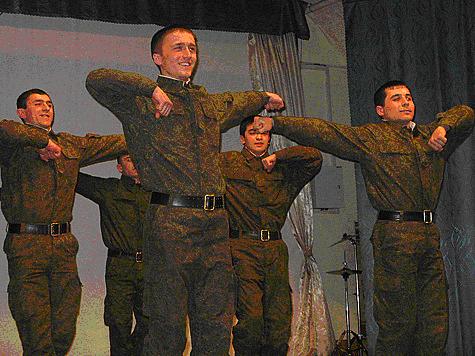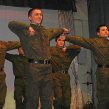
The Russian Army, Lezginka and Eastern Promise
Publication: Eurasia Daily Monitor Volume: 8 Issue: 61
By:

In early March, a group of Russian defense journalists visited military infrastructure in the Russian Far East. In a lengthy article in Moskovskiy Komsomolets, Olga Bozhyeva said she was asked by the defense ministry to visit Transbaykal for one week to see the progress of the “new look.” Bozhyeva recalled that the Transbaykal Military District was regarded in the Soviet era as a place where officers were sent to be forgotten; the Russian acronym for the district was interpreted to really mean zabyli vernut obratno (they forgot to bring me back) (Moskovskiy Komsomolets, March 10).
Viktor Litovkin, also saw military facilities in the new East Military District/Joint Strategic Command (OSK). Litovkin visited the 212th District Training Center in Peschanka and the 29th Combined-Arms Army (CAA) in Chita. Evidently, the defense ministry wanted to highlight new simulators, renovated officers’ accommodation, educational buildings as well as drawing attention to the outsourcing of catering and that personnel spent a minimum of eight hours daily in training, in addition to time devoted to their individual physical fitness. The Commander of East MD/OSK, Admiral Konstantin Sidenko, envisages the completion of the outsourcing process by the end of 2011 (Krasnaya Zvezda, March 17). However there were deeper problems, such as fewer officers in the units consequently with an increased workload, lower numbers of contract personnel and depleted quantities of military specialists (Nezavisimoye Voyennoye Obozreniye, March 7).
Positive features were noted by defense journalists, though Bozhyeva, a skeptic about the reform, was critical of the actual conditions in East MD/OSK. The 29th CAA Commander, Major-General Aleksandr Romanchuk, admitted that most conscripts fail to achieve satisfactory grades in their training. The 212th District Training Center, which trains 32 types of specialists ranging from tank commanders to engineers and signals personnel, where Leonid Brezhnev once served, revealed the overstretched nature of the training. One commander observed: “There are more troops, but without junior specialists, combat readiness decreases many times.” Officers admitted that tank drivers and tank gunners cannot possibly be trained in such short timescales, largely dependent on conscripts serving for twelve months (Moskovskiy Komsomolets, March 10).
Bozhyeva also visited Domna airbase, the only facility in Transbaykal where fighter and ground-attack aircraft are based. The commander of the airbase, Colonel Aleksandr Tomashev, stated that all aircraft were in working order and that the priority is to train 3rd class pilots flying 50 to 70 hours annually. In the 1990’s officers lamented the lack of jet fuel. However now there are sufficient quantities but it has been 15 years since the last new aircraft arrived. Salaries are not low by local standards: a 1st class pilot is paid 60,000 rubles ($2,114) monthly and a squadron commander 87,000 rubles ($3,064), while the average salary for flying staff is 30,000 rubles ($1,057) to 45,000 rubles ($1,585) and technical personnel from 17,000 rubles ($598). One air force officer noted that the reform has cut the number of specialists. Whereas 150 ground crew staff prepared one aircraft to conduct a combat mission that number has now halved. There are only 130 technicians left on the base, and in the past these were officer posts but have now been demoted to sergeants. Moreover, the military has had difficulties retaining lieutenants and captains.
Approximately 100 kilometers from the border with China, in the 36th Separate Motorized Rifle Brigade in Borzya, officers complained that they knew nothing of unmanned aerial vehicles or high-precision weaponry: training is conducted using Soviet-era T-62 and T-72 tanks and BMP-1 infantry fighting vehicles. In the fall of 2010, the defense ministry ordered a reduction of 70 percent of all contract personnel. Officers were skeptical about the prospect of increased numbers of kontraktniki arriving anytime soon. One officer in the brigade recounted the joke that the greatest difficulty an invading Chinese army would find in the Russian Far East is locating the Russian army, and then more seriously suggested their actual function is to protect China’s natural resources interests in Russia. The 200th Artillery Brigade in Drovyanaya conducted live firing from dated “Msta-B” 152 mm howitzers. Bozhyeva came across one conscript assigned to his howitzer after only six weeks of training in the unit, but was more persistent in asking officers if their potential enemies were “terrorists” or “Chinese,” only to be told that this was a strategic question (Moskovskiy Komsomolets, March 10; https://nvo.ng.ru/realty/2011-02-18/1_uklonisty.html, February 18).
Despite the promised introduction of the territorial principle of service, allowing conscripts to serve closer to home and take weekend leave, not all draftees are locals. Indeed, Bozhyeva saw Dagastani recruits performing the Lezginka, a traditional dance in the North Caucasus. Brigade Staff Chief, Colonel Oleg Tsokov, said that 90 percent of such recruits were from among the poor villages in the North Caucasus. Although commanders attempted to stress how well integrated these North Caucasus conscripts were, clearly they were posted as far from home as possible without any possibility of traveling home for the weekends. Given the low population density in the Russian Far East, it is understandable that applying such principles will prove problematic (Moskovskiy Komsomolets, March 10).
Aleksandr Pinchuk noted in Krasnaya Zvezda that the shortening of the initial conscript training period to from five months to three months is not working well. The first month concentrates on general military training, individual specialties in the second and the third month focuses on training with the unit. After completing this “intensive” training, 90 percent of recruits are sent to units in East MD/OSK and the remainder is transferred to the reserve awaiting a decision on where their service will continue. Major-General Sergey Sudakov, the head of the 212th District Training Center, said the number of hours training each week has been cut to one hour each for studying manuals, drills, ceremonies, medics, and topography leaving the focus on driving, firing and tactical training. Sudakov highlighted the weakening health standards among conscripts, proving more susceptible to colds, flu and respiratory diseases; this year in his view was better than last year (Krasnaya Zvezda, March 10).
Manpower problems and the lack of modernizing the military infrastructure are particularly acute in the Russian Far East. Significant investment will be required to break the mould of a bygone era. As the spring draft begins on April 1, the promise of better times ahead fails to convince many, while demographic challenges will ensure that the Lezginka remains a part of military life in East MD/OSK.




